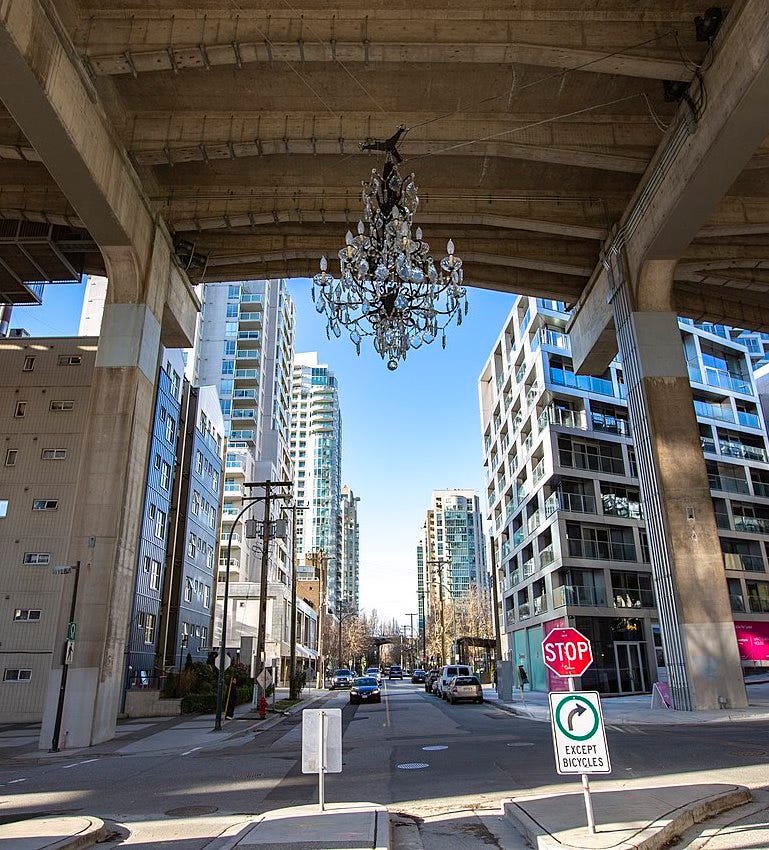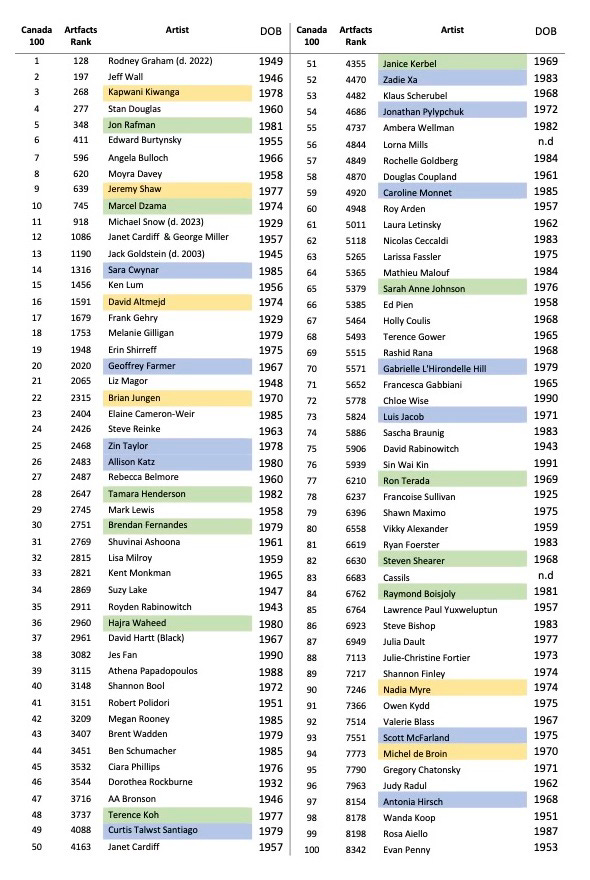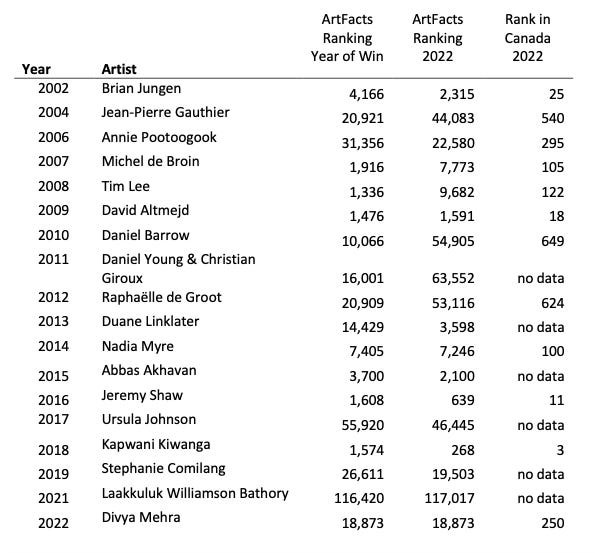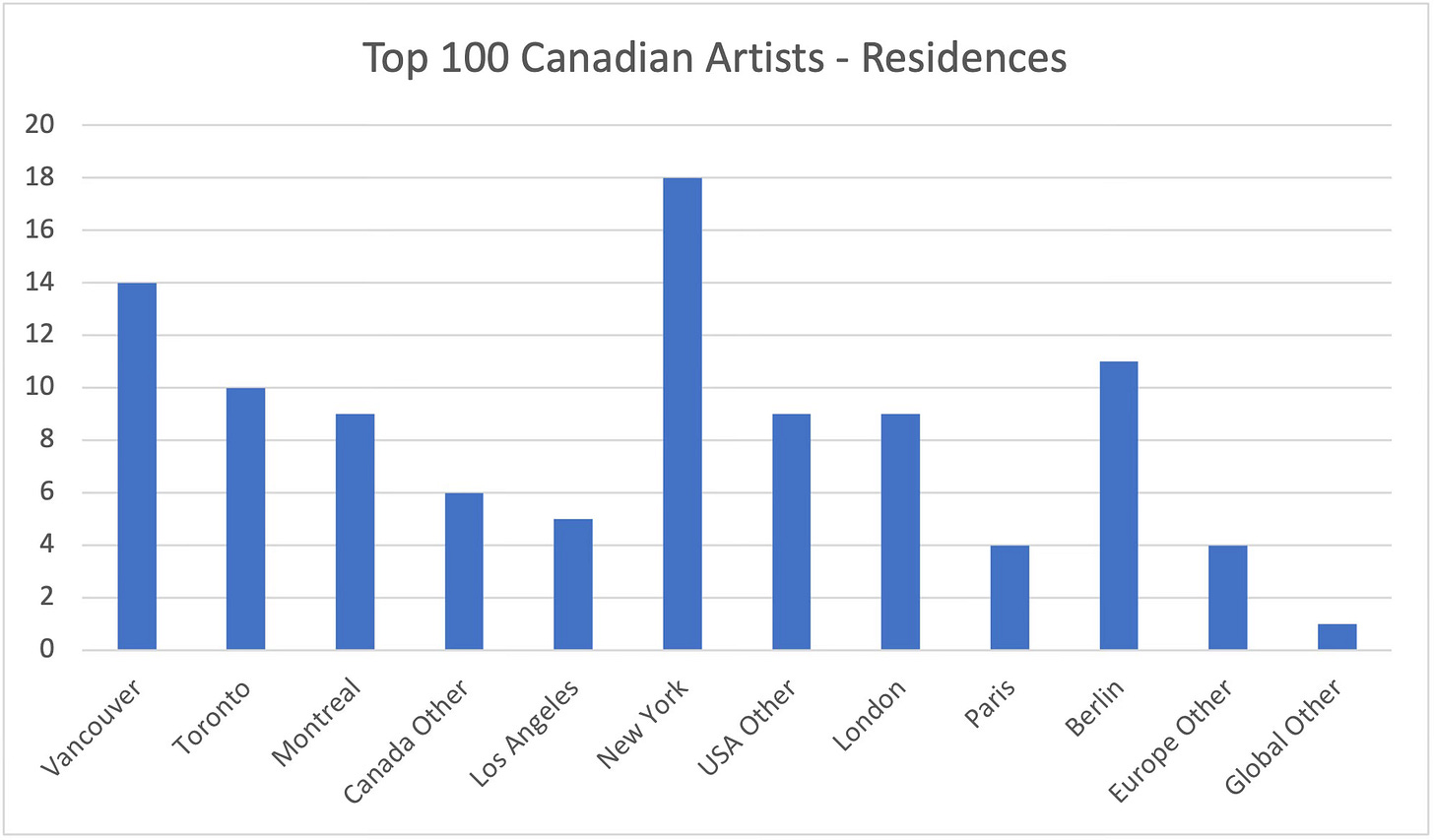Canada's Top 100 Artists
What Artfacts.net Can Tell Us About Canadian Contemporary Art

Who are the top contemporary artists in Canada? This is a question I pondered as I was conducting my research on the Sobey Art Award over the past two years. The nominees for this prestigious and valuable award are chosen every year by a different jury committee comprised of curators from across the country.1 Each curators selects five artists from their region who they feel have made an exemplary contribution to contemporary art in Canada. As my research found, most of these nominees also have a post-secondary visual arts education and, at the time of nomination, had already exhibited in solo and group exhibitions in Canada. Many had also exhibited internationally.2 The nominee list, then, provides a good source for identifying contemporary artists in Canada. The list, however, is very Canada-centric; that is the artists are Canadian artists chosen by Canadian curators. This left me to wonder, who are the Canadian artists most notable outside of Canada and how do they compare to the Sobey nominees?
For an objective answer to this question, I turned to the contemporary art database, Artfacts.net. Artfacts.net, in case you missed it in one of my earlier posts, tracks the reputations of contemporary artists by recording their exhibition records. Artfacts has been collecting data since 2001 and now tracks over one million exhibitions and over 900,000 artists worldwide. Each exhibition that an artist has is given a value based on a number of criteria: the importance of the venue (for example, an exhibit at the Tate Modern in London is more valuable than an exhibit at the Vancouver Art Gallery); whether the exhibition is solo or group; and, which other artists exhibit with a given artist. The total score is then run through an algorithm which establishes a ranking that represents an artist’s reputation in the international Art World. On their website, Artfacts publishes the results of their data in a list of the Top 100 worldwide artists, both living and deceased. Deceased artists are included as long as their artwork continues to be featured in museums and galleries. The Top 100 artists then include the most recognized names in modern and contemporary art: Andy Warhol, Louise Bourgeois, and Picasso, for example, and living artists like Cindy Sherman, Gerhard Richter, and Ai Weiwei.
The database, like many such tools, is not perfect. It depends on the accuracy of the data and how the data is updated over time. Artfacts documents and verifies thousands of exhibitions every year. The documentation, however, is not always up-to-date and thus may skew an artist's ranking. Studies of Artfacts and another similar art database, KunstKompass, have also shown how these databases tend to favour Euro-American artists over artists from other parts of the world.3 These biases reflect the importance of, and thus greater value given to, commercial galleries and public museums in places like New York and Berlin. These locations and their venues have been, and continue to be, significant in establishing the recognition of contemporary art and artists. In the years since this research was published, Artfacts has added thousands of venues and events outside of the Western art centers which has helped to diversify the results of their data collection.
Despite these issues, Artfacts’ data compilation still provides useful insights into how well Canadian artists are recognized in the institutions of the international Art World. In 2022, Artfacts very generously allowed me free access to their site for a few days so I could collect data on the Sobey Art Award nominees. Subscribers can filter Artfacts data to come up with a list of artists in a specific nation. Here is the list of top 100 living Canadian artists that I drew up in 2022:
The chart shows each artists’ ranking in Canada (Canada 100 column on the left) followed by their ranking on Artfacts’ global 100 list.4 As we see in this column, no Canadian artist is included in the top 100 worldwide ranking. Rodney Graham, who passed away in October 2022 after I had completed my research on the database, comes closest at 128. He was also Canada’s top ranked artist that year. Graham, along with ten other artists on this list, fall within the top 1,000 living artists in the world. These artists, like the top 100, are featured in the prestigious museums and commercial galleries around the world. Graham, for example, is represented by at least two top commercial galleries (Lisson Gallery in London and Hauser & Wirth in Zurich) and has had numerous solo exhibitions in important museums in Toronto, Vancouver, Zurich, Vienna, New York, London, and Paris since 1979. He also represented Canada at the Venice Biennale in 1997. The fact that Graham is at the top of this list indicates that he continued to be active throughout his lifetime and his work has retained its value in the contemporary art world. Despite his death in 2022, his high ranking on Artfacts will continue as long as his artworks are featured in contemporary art exhibitions.
Number three on the list of 100, Kapwani Kiwanga, is much younger than Graham and the second place artist, Jeff Wall. Like Graham and Wall, her score has been enhanced by numerous solo and group exhibitions in Europe and the United States, as well as commercial gallery representation in several countries. She has also been the recipient of a number of prestigious art awards in France, Switzerland, and in Canada where she won the Sobey Art Award in 2018. The awards, along with her many exhibitions, have pushed Kiwanga's ranking to the top alongside Graham and Wall who have had much longer artistic careers. To remain in this top position, Kiwanga will have to sustain her very active artistic practice and continue to gain exhibitions in significant venues. Last year, Kiwanga was named Canada’s representative artist for the Venice Biennale this Spring. This exhibition will no doubt help her to maintain her ranking, if not push it further up the list.
The remaining artists on the list fall within the top 10,000 worldwide artists which is still a very respectable ranking when one considers that the database tracks nearly a million artists and a million different venues. Sobey nominees and winners, like Brian Jungen, Sara Cwynar, and David Altmejd have commercial gallery representation, have had solo exhibitions in international venues, and have participated in events like international biennales and art fairs. To move up in the ranks they need to continue to exhibit in more significant museums in Canada and beyond.
What I found notable in light of my Sobey Award research is that nearly thirty percent of the artists on the Top 100 (29%) are Sobey Art Award winners or nominees (highlighted names). Six of these artists are award winners (yellow highlight), eleven were shortlisted at least once (green highlight), and the remaining (blue highlight) were nominated at least once in the twenty years of the award. Twenty-nine percent is a healthy number of artists considering that until 2021 at least another quarter of the artists on the Artfacts list would not have qualified for a Sobey nomination because of their age. Prior to 2021, artists had to be under the age of forty. For the Sobey Art Award nominees, recognition in the top 10,000 worldwide artists indicates that they have successfully gained international recognition for their work. Whether the Sobey Award had a major effect on this position, however, is difficult to measure. As the chart of Sobey winners below indicates, half of the Sobey winners were already ranked in the top 10,000 on Artfacts prior to their nomination for the award. This means that they had already gained significant international recognition prior to nomination. Furthermore, not all of the Sobey shortlisted artists improved their ranking by 2022 as the chart below indicates.5
While the Sobey nominees have a strong presence on the Artfacts 100 list, I was surprised to find so many artists (39) who I did not recognize or even know to be Canadian. Nationality on Artfacts is a rather sticky category. Nationality is usually the country of birth and may not be where an artist spent most of their lives. Architect Frank Gehry, for example, is listed in the top 100 list of Canadian artists yet has lived and worked most of his life in the United States. Checking the residences of the artists I did not know, I found they too make their homebase outside of Canada, either in the United States or Europe. More research would be needed to determine the relationship the artists have with Canada and whether they have an exhibition history in Canada. When considering the question of who is a Canadian contemporary artist in the international art world then, I realize that artists, like so many other professionals, choose to live outside Canada in order to be closer to the centres of their profession.
While Artfacts tracks nationality, gender, and age, it does not consider these nor other factors such as racial diversity, education, or place of residence in its ranking calculations. I decided to investigate these factors as I had done with the list of Sobey nominees.
In terms of gender, the list is similar to the Sobey nomination list in that the list is almost equally divided by male and female artists: 51 males, 46 females and 3 artists who identify as gender neutral.
Racialized artists are slightly better represented on the Top 100 list than the Sobey list. According to Statistics Canada (2021), 26.5% of the population belongs to a racialized group (Asian, Filipino, Middle Eastern, Indian or of African descent). Only 17% of the Sobey nominees are racialized artists while 24% are racialized on the Top 100 list.
Indigenous and Métis artists, on the other hand, have a stronger presence on the Sobey list. Nine percent of the artists on the Top 100 list are Indigenous or Métis while 16% on the Sobey list are in this category. Both numbers are greater than 5% which is Canada’s average for Indigenous and Métis population. This result suggests that Indigenous and Métis artists are well represented in Canada and have also gained considerable attention internationally.
Like the Sobey nominees almost all the artists on the 100 list (all but two) have completed some post-secondary art education (BFA or MFA), again demonstrating the importance of visual art education as a qualifying step for contemporary artists.6 A large majority of the artists completed some of their studies in Canada while 18% of the artists studied solely outside of Canada.
Unlike the Sobey nominees, a majority of the artists on the 100 list, 61%, live outside of Canada choosing New York as the top cultural centre as the chart below indicates. Surprisingly, in Canada, Vancouver rather than Toronto or Montréal, ranks as the favoured residence for a majority of Canada’s Top 100 contemporary artists. These results suggest that living in one of world’s contemporary art centres outside of Canada does help an artist get noticed. On the other hand, Rodney Graham and Jeff Wall, chose to reside in Vancouver and still climbed to the top of the 100 list.
Who are the top Canadian artists? Through its objective data collection, the Artfacts Top 100 list provides a picture of the most visible Canadian artists in the Art World, that is those artists who have had an exemplary international exhibition record. Artists, like Kiwanga, Wall, and Graham are among the top 1,000 artists in the world putting them in a reputational class along with artists like Peter Doig, Theaster Gates, Amy Sillman, and Barbara Kruger. The Sobey Art Award nominee list, on the other hand, provides a more subjective and Canadian-centric picture of Canada's top artists. These are artists who are first and foremost valued in Canada. They include artists who have established their reputation over time and have long exhibition records such as Marcel Dzama (first nominated in 2004) who have not won the Sobey Art Award but still appear in the top 1,000 on the Artfacts 100 list. The Sobey nominees also include many "emerging" artists. Divya Mehra and Howie Tsui, for example, have had fewer exhibitions and rank within the top 100,000 on Artfacts. The Sobey nominee list then provides an excellent sample of which artists Canadians value while Artfacts allows us to see how these artists have transitioned into the very competitive field of international contemporary art.
Each jury also includes an invited international professional. See https://www.gallery.ca/whats-on/sobey-art-award/nominations.
Alain Quemin, “The Impact of Nationality on the Contemporary Art Market.” Sociologia & Antropologia 5-3 (2015): 825-56; Larissa Buchholzand Ulf Wuggenig, “Cultural Globalization between Myth and Reality: The Case of the Contemporary Visual Arts.” Art-e-fact: Strategies of Resistance: Glocalogue 04 (2005): http://artefact.mi2.hr/_a04/lang_en/theory_buchholz_en.htm.; and, Ulf Wuggenig, “The Empire, the NorthWest and the Rest of the World. ‘International Contemporary Art’ in the Age of Globalization.” Translated by Aileen Dereig. http://www.republicart.net (09-2002): 5.
N.d. means that no data could be found. Also, note that number 13 on the list, Jack Goldstein died in 2003 and should not be on the list of “living artists.” Artfacts has a number of these kinds of errors where an artist’s information has not been updated.
There are some discrepancies between the ranking numbers on this chart and the chart above. I am not sure why this is as I obtained the data within a four-day period. It may indicate how Artfacts’ ranking list fluctuates, even within a few days.
Gary Alan Fine, Talking Art: The Culture of Practice and the Practice of Culture in MFA Education (Chicago: University of Chicago Press, 2018).






